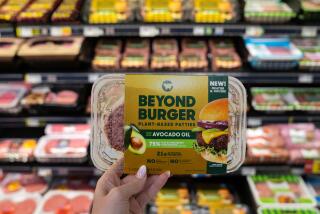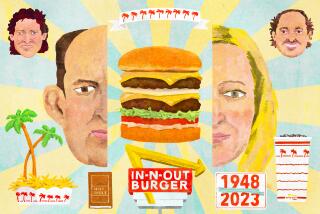What Happened to Plain Old Hamburger?
- Share via
It is time again to talk about ground beef labeling. In my opinion you, we, are all collectively being “had” more often than not when it comes to buying ground beef, even in some of the best of places. It’s not the way it should be. It’s certainly not the best way, nor the right way. It may not be what you could call dangerous. But neither is it very safe.
Anyway, there is one chain of supermarkets that promotes the fact that they feature five types of ground beef: regular ground beef, premium ground beef, ground chuck, ground round and ground sirloin.
Five Kinds at Six Prices
The market in my neighborhood had all five in the meat case recently with six different prices. Regular, which on its label is said to contain 30% fat, was $1.19 per pound. But, if you bought 3 pounds or more you could get it for 99 cents a pound. Premium, which was “not more than 22% fat,” was a $1 a pound more at $2.19. For the same price, you could get ground chuck, which contained “not more than 26% fat.” While the fat content of premium and chuck were different, the price of $2.19 per pound was the same for both. Ground round had the same fat content as premium--22%--but was priced 70 cents a pound more at $2.89 versus $2.19. They didn’t tell you on the label how much fat there was in ground sirloin, but it was the most expensive at $3.19 per pound.
It all gets very confusing, doesn’t it? And it gets even more so when we start examining the government regulations regarding ground beef labeled lean and extra lean.
Whatever happened to plain old hamburger?
It might make things a little easier to comprehend if you knew a bit about how ground beef is made--really made (regardless of the label) from a butcher’s perspective--behind the scenes. It could change buying habits and save some money.
Most ground beef is now, and always has been, made from the trimmings that are a natural result of the meat cutting process. One of my first jobs in my dad’s butcher shop was boning out and trimming beef necks, flanks and plates, the thin underpart of the beef’s forequarter, to be used for hamburger. We might save the best trimmings from the flank, neck and shank for lean ground round, but most of the trimmings were ground into plain old-fashioned hamburger.
Today, it would be labeled regular ground beef--does not exceed 30% fat. To make lean ground beef, we used bull. Lean bull meat came frozen in 30 or 40 pound boxes. We would add lean bull meat to our regular trimmings to make lean ground beef. It was good; there is nothing wrong with bull meat. It has good flavor, but ground sirloin it is not.
To make ground sirloin, we used to take the leanest trimmings from the flank, neck and shanks, grind it once through the coarse plate of the meat grinder and once through the fine plate to make ground round and a second time through the fine plate to turn--as if by magic--ground round into ground sirloin.
Trimming Done at Packing Plant
In my opinion butchers don’t do deceptive things like that anymore, and they don’t even do much trimming. Beef doesn’t come into the meat market in carcass form any longer so there are no necks or plates or flanks to trim. Today, all of the trimming and boning is done at the packing plant.
The trimmings are ground once through the grinder’s coarse plate. Sophisticated electronic and/or sonic devices, which measure the diffusion or density of fat and lean, are used to test for fat content of each batch. The coarse ground meat is packed in large plastic tubes, labeled according to its percentage of lean and sent to the retail market where it is ground a second time through the fine plate and packaged for the meat case. The labeling at retail usually carries some indication of the fat content, i.e., “regular ground beef--contains no more than 30% fat.”
When ground beef and hamburger are labeled as lean or extra lean they must, according to the Department of Agriculture, have at least a 25% reduction in fat from the regulatory standard of 30% fat (i.e., they can contain no more than 22.5% fat).
The only difference, really, between one ground beef and another is fat content, and you very often pay a big premium for very little less fat. Taking my local supermarket as an example, the most expensive ground beef was selling for nearly 200% more money for only 8% less fat.
By far the best way to be sure of what you’re getting when you buy ground beef is to buy the beef and grind it yourself. You’ll very quickly save enough money to pay for a home meat grinder.
In the same market where ground chuck was $2.19 per pound, boneless chuck roast was $1.77 per pound, ground round was $2.89, but you could buy round steak for $1.98 per pound. Even top sirloin steak at $2.99 was less expensive than ground sirloin at $3.19. Usually that is not the case.
Whenever I see ground sirloin selling for less than the sirloin steak it was supposed to be made from, I always check at the checkout stand to see if perhaps they have Rolex watches for $19.95. Who knows?
More to Read
Eat your way across L.A.
Get our weekly Tasting Notes newsletter for reviews, news and more.
You may occasionally receive promotional content from the Los Angeles Times.










